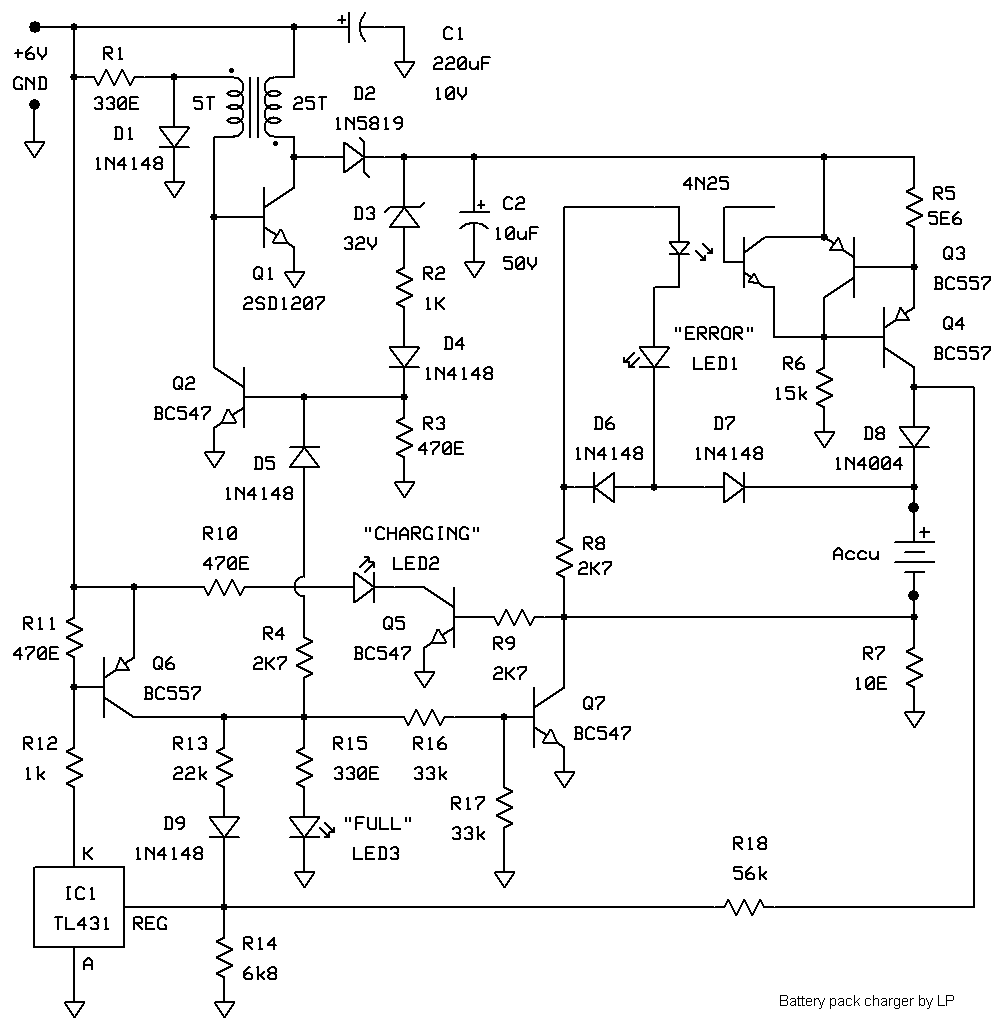As the technology progresses, hand- and AC powered tools such as screwdrivers and drills get replaced by their cordless battery powered siblings. That's handy, but once and a while their dedicated battery pack chargers die. The tool itself is thus rendered useless despite being in perfectly working condition. If you had a similar misfortune as the author of this article had, build this simple and cheap charger and continue using the old-faithfull tool.
Generating high voltage
Charger circuit presented here is able to charge NiCd and NiMH battery backs up to more than 30V. This is more than enough for charging all cordless tool batteries as they come in two main cathegories - amateur tools usually use 14.4V packs, while professional ones prefer 19,2V packs. The specific problem that this circuit solves is charging battery packs of higher voltage than is the available output voltage of the AC-DC converter which it uses as an energy supply source.

As can be observed on the diagram to the left, high DC voltage is generated solely by Q1 transistor and a small ferrite transformer that it is connected to. This is a standard boost blocking converter topology in which high frequency high voltage peaks are induced periodically in the secondary winding of the transformer (25T), which diode D2 traps and rectifies into DC in order to charge cappacitor C2. From the standpoint of external loads connected to it, C2 behaves as a high DC voltage battery. In order for the circuit to operate efficiently, it is necessary that Q1 be of a special sort, a so called
switch transistor. Those are carefully designed so that they are able to maintain extremely low
Vces saturating voltage between the emitter and the collector when conducting large currents. For example, instead of standard saturating voltage of 0.2V
ces that most silicon transistors show, 2SD1207 is able to conduct so hard that even at 2A of collector current it produces as little as 40mV of V
ces. This leads to very low power dissipation losses as they depend on the
product of instant collector current and voltage between the collector and emitter.
In this particular application, the turns ratio of the transformer is not very critical and should be close to the data given in the diagram. The ferrite transformer is very small - cores with dimensions 2cm x 2cm x 1cm are more than enough for problem free operation. If the circuit refuses to generate high voltage at C2, simply swap the starting and ending lead of either the primary or the secondary winding. Dots in the diagram mark the right direction of winding the turns. Small signal transistor Q2 is used to stop Q1 should the voltage on C2 exceeds approximately 33V. This protects Q1 from high voltage breakdown since left to their own, boost converters are able to generate extremely high voltages at the output. A beautiful explanation on how boost converters of this kind operate can be found at the following address:
www.ludens.cl.
The rest of the circuit is used to control the charging process and to indicate the state of battery charge. Those functions are explained on the following page.

 As can be observed on the diagram to the left, high DC voltage is generated solely by Q1 transistor and a small ferrite transformer that it is connected to. This is a standard boost blocking converter topology in which high frequency high voltage peaks are induced periodically in the secondary winding of the transformer (25T), which diode D2 traps and rectifies into DC in order to charge cappacitor C2. From the standpoint of external loads connected to it, C2 behaves as a high DC voltage battery. In order for the circuit to operate efficiently, it is necessary that Q1 be of a special sort, a so called switch transistor. Those are carefully designed so that they are able to maintain extremely low Vces saturating voltage between the emitter and the collector when conducting large currents. For example, instead of standard saturating voltage of 0.2Vces that most silicon transistors show, 2SD1207 is able to conduct so hard that even at 2A of collector current it produces as little as 40mV of Vces. This leads to very low power dissipation losses as they depend on the product of instant collector current and voltage between the collector and emitter.
As can be observed on the diagram to the left, high DC voltage is generated solely by Q1 transistor and a small ferrite transformer that it is connected to. This is a standard boost blocking converter topology in which high frequency high voltage peaks are induced periodically in the secondary winding of the transformer (25T), which diode D2 traps and rectifies into DC in order to charge cappacitor C2. From the standpoint of external loads connected to it, C2 behaves as a high DC voltage battery. In order for the circuit to operate efficiently, it is necessary that Q1 be of a special sort, a so called switch transistor. Those are carefully designed so that they are able to maintain extremely low Vces saturating voltage between the emitter and the collector when conducting large currents. For example, instead of standard saturating voltage of 0.2Vces that most silicon transistors show, 2SD1207 is able to conduct so hard that even at 2A of collector current it produces as little as 40mV of Vces. This leads to very low power dissipation losses as they depend on the product of instant collector current and voltage between the collector and emitter.